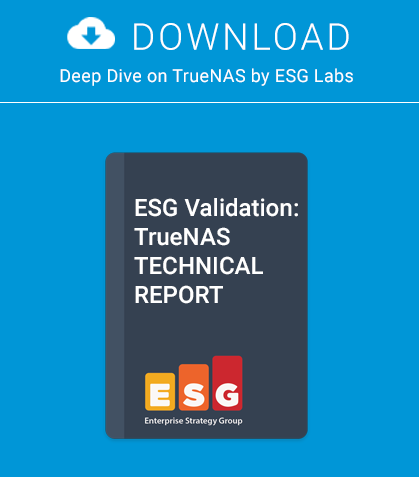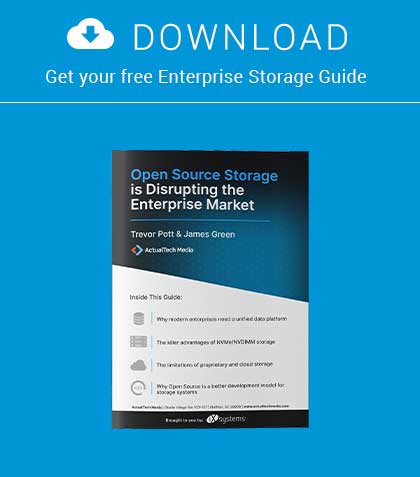NOTE: This is historical content that may contain outdated information.
In addition to protecting data from catastrophic failure, TrueNAS® is also designed to protect the data on the array in case of a drive failure. It uses software RAID to provide redundancy for disks and replace the data on them when things go wrong. Most storage arrays use hardware RAID to provide redundancy for the data on disks and replace this data when things go wrong. The wide usage of hardware RAID leads many users to mistakenly view hardware RAID as superior to software RAID.
Here is a quick overview of RAID technology. RAID originally stood for Redundant Array of Inexpensive Disks, but most now call it a Redundant Array of Independent Disks. RAID was invented in 19871 at UC Berkeley and has become prevalent in both consumer-grade and enterprise-grade storage arrays. The concept is simple: a RAID array is just a collection of disks in a storage pool accessed by the file system as a single logical volume. A typical storage array has groups of these logical volumes or RAID sets. Depending on the version, or level, of RAID implemented, the failure of one disk does not affect the availability of the storage array, as most RAID levels increase data availability.
TrueNAS is based on the Open Source software RAID in OpenZFS which means TrueNAS does not embed the RAID technology in proprietary hardware or firmware. Hardware RAID technology relies on hardware caching mechanisms and assumes it can supplement the dedicated DRAM cache on disks that can be critical for acceptable performance. TrueNAS hardware is optimized for the RAID technology. The RAID technology used by TrueNAS enables close integration of the RAID structure and underlying file system for superior throughput from disks compared to hardware RAID.
Most RAID levels use a parity calculation to protect data in the event of a disk failure. Think of the parity calculation as an insurance policy on the life of a disk in a RAID array. If a disk fails, the storage array becomes degraded, and the system recreates the missing data on a replacement disk by using a mathematical formula on the data and parity from the remaining disks. After replacing the failed disk, the system rebuilds the new disk so it has identical data as the failed disk. The rebuilding operation recreates the missing data using the same parity process and copies it to the new disk. When the rebuild completes, the storage array is no longer in a degraded state.
RAID does not prevent data failures, it only addresses drive failures. Traditional hardware RAID however offers no protection from data corruption, such as from ransomware, bit rot, acts of nature, or deliberate corruption. The file system or a backup product must provide this protection.
TrueNAS integrates software RAID protection with its file system and has knowledge of how much data is on-disk at all times. This means that it intelligently decides if any given byte on a disk is in use during the rebuilding process. Hardware RAID does not know if a byte on a disk is in use by the file system, so it blindly copies every block during its rebuilding process whether it’s an active block or not. This makes for a significant difference when rebuilding. For example, if you have 40GB of data on a 4TB disk, TrueNAS will only rebuild 40GB or 1% of the 4TB drive. Hardware RAID copies all 4TBs, so hardware RAID has to copy 99x more data. If you are using 3TB of a 4TB drive, TrueNAS has to copy only 3TB, while a hardware RAID has to copy that 3TB and another 1TB, or 33% extra.
An additional benefit of the TrueNAS software RAID is that if your rebuilding operation is interrupted, say with a power failure, TrueNAS will start where it left off whereas hardware RAID has to start at the beginning. If you have a 4TB drive with 3TB copied, TrueNAS has to copy 1TB after a restart from the power failure, but hardware RAID has to copy four times as much.
You can become a RAID hero by using the intelligent rebuilding technology in TrueNAS. If you’d like more information on TrueNAS and its RAID technology, send an email to sales@ixsystems.com or call 1-855-GREP-4-IX.
Gary Archer, Director of Storage Marketing / Michael Dexter, Sr. Analyst
1 Patterson, David; Gibson, Garth A.; Katz, Randy(1988). A Case for Redundant Arrays of Inexpensive Disks (RAID). SIGMOD Conference.




